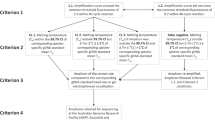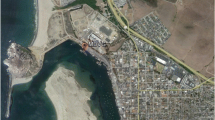Abstract
Ceratonova shasta is the etiological agent of myxozoan-associated enteronecrosis in North American salmonids. The parasite’s life cycle involves waterborne spores and requires both a salmonid fish and a freshwater fabriciid annelid. The success and survival of annelids can be enhanced by flow moderation by dams, and through the erosion of fine sediments into stream channels following wildfires. In this study, the presence of C. shasta environmental/ex-host DNA (eDNA) in river water and substrate samples collected from areas affected by recent fire activity in California, USA, was investigated. Additionally, DNA loads in the environment were compared to C. shasta infection in sentinel-exposed rainbow trout (Oncorhynchus mykiss). Significant associations between C. shasta detection in environmental samples and location within a wildfire perimeter (p = 0.002), between C. shasta detection in sentinel fish and exposure location within a wildfire perimeter (p = 0.015), and between C. shasta detection in fish and locations where water temperature was above the median (p < 0.001) were observed. Additionally, a higher prevalence of C. shasta infection in fish was detected where C. shasta was also detected in environmental samples (p < 0.001). Results suggest that pathogen eDNA sampling can be used as a non-invasive, rapid, specific, and sensitive method for establishing risk of C. shasta infection in wild populations. Knowledge of the complete life cycle of the target parasite, including ecology of each host, can inform the choice of eDNA sampling strategy. Environmental DNA sampling also revealed a novel species of Ceratonova, not yet observed in a host.



Similar content being viewed by others
References
Alexander JD, Hallett SL, Stocking RW, Xue L, Bartholomew JL (2014) Host and parasite populations after a ten year flood: Manayunkia speciosa and Ceratonova (syn Ceratomyxa) shasta in the Klamath River. Northwest Science 88:219–233
Alexander JD, Kerans BL, El-Matbouli M, Hallett SL, Stevens L (2015) Annelid-myxosporean interactions. In: Okamura B, Gruhl A, Bartholomew JL (eds) Myxozoan evolution, ecology and development. Springer
Atkinson SD, Bartholomew JL (2010a) Disparate infection patterns of Ceratomyxa shasta (Myxozoa) in rainbow trout Oncorhynchus mykiss and chinook salmon Oncorhynchus tshawytscha correlate with ITS-1 sequence variation in the parasite. Int J Parasitol 40:599–604
Atkinson SD, Bartholomew JL (2010b) Spatial, temporal and host factors structure the Ceratomyxa shasta (Myxozoa) population in the Klamath River Basin. Infect Genet Evol 10:1019–1026
Atkinson SD, Foott JS, Bartholomew JL (2014) Erection of Ceratonova n. Gen. (Myxosporea: Ceratomyxidae) to encompass freshwater species C. gasterostea n. sp. from threespine stickleback (Gasterosteus aculeatus) and C. shasta n. comb. from salmonid fishes. J Parasitol 100:640–645
Atkinson SD, Hallett SL, Bartholomew JL (2018) Genotyping of individual Ceratonova shasta (Cnidaria: Myxosporea) myxospores reveals intra-parasite ITS-1 variation and invalidates the distinction of genotypes II and III. Parasitology 145:1588–1593
Arsan EL, Hallett SL, Bartholomew JL (2007) Tubifex tubifex from Alaska and their susceptibility to Myxobolus cerebralis. J Parasitol 93:1332–1342
Bartholomew JL (2012a) Salmonid Ceratomyxosis. In: AFS-FHS (American Fisheries Society-Fish Health Section). FHS blue book: suggested procedures for the detection and identification of certain finfish and shellfish pathogens, 2016 edition. Accessible at: https://units.fisheries.org/fhs/fish-health-section-blue-book-2016/
Bartholomew JL (2012b) Salmonid ceratomyxosis methods appendix I. In: AFS-FHS (American Fisheries Society-Fish Health Section). FHS blue book: suggested procedures for the detection and identification of certain finfish and shellfish pathogens, 2016 edition. Accessible at: https://units.fisheries.org/fhs/fish-health-section-blue-book-2016/
Bartholomew JL, Holt RA, Alexander JD, Atkinson SD, Craig R, Javaheria A, Babar-Stevens M, Hallett SL (2016) Klamath River Fish Health Studies: Salmon Disease Monitoring and Research. http://microbiology.science.oregonstate.edu/sites/microbiology.science.oregonstate.edu/files/bartholomew/KlamathRiverFishHealth_FY2016_annualreport_06012017final.pdf
Bartholomew JL, Whipple MJ, Stevens DG, Fryer JL (1997) The life cycle of Ceratomyxa shasta, a myxosporean parasite of salmonids, requires a freshwater polychaete as an alternate host. J Parasitol 83:859–868
Bartholomew JL, Atkinson SD, Hallett SL (2006) Involvement of Manayunkia speciosa (Annelida: Polychaeta: Sabellidae) in the life cycle of Parvicapsula minibicornis, a myxozoan parasite of Pacific salmon. J Parasitol 92:742–748
Betts EF, Jones JB Jr (2009) Impact of wildfire on stream nutrient chemistry and ecosystem metabolism in boreal forest catchments of interior Alaska. Arct Antarct Alp Res 41:407–417
Bjork SJ, Bartholomew JL (2009a) The effects of water velocity on the Ceratomyxa shasta infectious cycle. J Fish Dis 32:131–142
Bjork SJ, Bartholomew JL (2009b) Effects of Ceratomyxa shasta dose on a susceptible strain of rainbow trout and comparatively resistant Chinook and coho salmon. Dis Aquat Org 86:29–37
Brinkhurst RO (1996) On the role of tubificid oligochaetes in relation to fish disease with special reference to the Myxozoa. Annu Rev Fish Dis 6:29–40
Bass D, Stentiford GD, Littlewood DT, Hartikainen H (2015) Diverse applications of environmental DNA methods in parasitology. Trends in Parasitology 31:499–513.
Ficetola GF, Miaud C, Pompanon F, Taberlet P (2008) Species detection using environmental DNA from water samples. Biol Lett 4:423–425
Foott JS (2013 and 2014) Sacramento and Feather River Juvenile Chinook Pathogen Survey Spring. National Wildfish Survey. U.S. Fish & Wildlife Service California – Nevada Fish Health Center, Anderson, CA. http://www.fws.gov/canvfhc/reports.asp
Foott JS, Jacobs J, Imrie A (2016) Prevalence and severity of Ceratonova shasta and Parvicapsula minibicornis infection of natural Feather River Juvenile Chinook Salmon (January–May 2015). U.S. Fish & Wildlife Service California - Nevada Fish Health Center, Anderson, CA http://www.fws.gov/canvfhc/reports.asp
Fox MD, Palenzuela O, Bartholomew JL (2000) Strategies for the diagnosis of Ceratomyxa shasta using the polymerase chain reaction: comparison of lethal and nonlethal sampling with microscopic examination. J Aquat Anim Health 12:100–106
Goldberg CS, Strickler KM, Pilliod DS (2015) Moving environmental DNA methods from concept to practice for monitoring aquatic macroorganisms. Biol Conserv 183:1–3
Granath WO Jr (2014) Effects of habitat alteration on the epizootiology of Myxobolus cerebralis, the causative agent of salmonid whirling disease. J Parasitol 100:157–165
Hall TA (1999) BioEdit: a user-friendly biological sequence alignment editor and analysis program for Windows 95/98/NT. Nucleic Acids Symp Ser 41:95–98
Hallett SL, Bartholomew JL (2006) Application of a real-time PCR assay to detect and quantify the myxozoan parasite Ceratomyxa shasta in river water samples. Dis Aquat Org 71:109–118
Hallett SL, Ray RA, Hurst CN, Holt RA, Buckles GR, Atkinson SD, Bartholomew JL (2012) Density of the waterborne parasite Ceratomyxa shasta and its biological effects on salmon. Appl Environ Microbiol 78:3724–3731
Helvey JD, Tiedemann AR, Anderson TD (1985) Plant nutrient losses by soil erosion and mass movement after wildfire. J Soil Water Conserv 40:168–173
Hurst CN, Wong P, Hallett SL, Ray RA, Bartholomew JL (2014) Transmission and persistence of Ceratonova shasta genotypes in Chinook salmon. J Parasitol 100:773–777
Hendrickson GL, Carleton A, Manzer D (1989) Geographic and seasonal distribution of the infective stage of Ceratomyxa shasta (Myxozoa) in Northern California. Dis Aquat Org 7:165–169
Krueger RC, Kerans BL, Vincent ER, Rasmussen C (2006) Risk of Myxobolus cerebralis infection to rainbow trout in the Madison River, Montana, USA. Ecol Appl 16:770–783
Kumar S, Stecher G, Tamura K (2016) MEGA7: Molecular Evolutionary Genetics Analysis version 7.0. Mol Biol Evol 33:1870–1874
Kent ML, Whitaker DJ, Dawe SC (1997) Parvicapsula minibicornis n. sp. (Myxozoa, Myxosporea) from the kidney of sockeye salmon (Oncorhynchus nerka) from British Columbia, Canada. J Parasitol 83:1153–1156.
Malakauskas DM, Willson SJ, Wilzbach MA, Som NA (2013) Flow variation and substrate type affect dislodgement of the freshwater polychaete, Manayunkia speciosa. Freshwater Science 32:862–873
Malakauskas DM, Wilzbach MA (2012) Invertebrate assemblages in the lower Klamath River, with reference to Manayunkia speciosa. Calif Fish Game 98:214–235
Malakauskas DM, Snipes RB, Thompson AM, Schloesser DW (2016) Molecular evidence of undescribed Ceratonova sp. (Cnidaria: Myxosporea) in the freshwater polychaete, Manayunkia speciosa, from western Lake Erie. J Invertebr Pathol 137:49–53
Meaders MD, Hendrickson GL (2009) Chronological development of Ceratomyxa shasta in the polychaete host, Manayunkia speciosa. J Parasitol 95:1397–1407
Molnár K, Eszterbauer E (2015) Specificity of infection sites in vertebrate hosts. In: Okamura B, Gruhl A, Bartholomew JL (eds) Myxozoan evolution, ecology and development. Springer
Noble ER (1950) On a Myxosporidian (Protozoan) Parasite of California Trout. J Parasitol 36:457–460
Palenzuela O, Trobridge G, Bartholomew JL (1999) Development of a polymerase chain reaction diagnostic assay for Ceratomyxa shasta, a myxosporean parasite of salmonid fish. Dis Aquat Org 36:45–51
R Core Team (2016) R: a language and environment for statistical computing. R Foundation for Statistical Computing, Vienna, Austria Available at: https://www.R-project.org/
Ray RA, Holt RA, Bartholomew JL (2012) Relationship between temperature and Ceratomyxa shasta–induced mortality in Klamath River salmonids. J Parasitol 98:520–526
Ray RA, Bartholomew JL (2013) Estimation of transmission dynamics of the Ceratomyxa shasta actinospore to the salmonid host. Parasitology 140:907–916
Richey CA, Kenelty KV, Van Stone HK, Stevens BN, Martínez-López B, Barnum SM, Hallett SL, Atkinson SD, Bartholomew JL, Soto E (2018) Distribution and prevalence of Myxobolus cerebralis in postfire areas of Plumas National Forest: utility of environmental DNA sampling. J Aquat Anim Health 30:130–143
Schrader C, Schielke A, Ellerbroek L, Johne R (2012) PCR inhibitors–occurrence, properties and removal. J Appl Microbiol 113:1014–1026
Stinson MET, Bartholomew JL (2012) Predicted redistribution of Ceratomyxa shasta genotypes with salmonid passage in the Deschutes River, Oregon. J Aquat Anim Health 24:274–280
Stocking RW, Bartholomew JL (2007) Distribution and habitat characteristics of Manayunkia speciosa and infection prevalence with the parasite Ceratomyxa shasta in the Klamath River, Oregon–California. J Parasitol 93:78–88
Teledyne ISCO (1994; rev 2011) 3700 Portable samplers: installation and operation guide. https://www.enviroequipment.com/sites/default/files/documents/instruments/isco-3700-manual.pdf
Thomsen PF, Willerslev E (2015) Environmental DNA–an emerging tool in conservation for monitoring past and present biodiversity. Biol Conserv 183:4–18
Udey LR, Fryer JL, Pilcher KS (1975) Relation of water temperature to ceratomyxosis in rainbow trout (Salmo gairdneri) and coho salmon (Oncorhynchus kisutch). J Fish Board Can 32:1545–1551
Zendt JS, Bergersen EP (2000) Distribution and abundance of the aquatic oligochaete host Tubifex tubifex for the salmonid whirling disease parasite Myxobolus cerebralis in the upper Colorado River basin. N Am J Fish Manag 20:502–512
Acknowledgments
We thank Dr. Matt J. Griffin from Mississippi State University for critical review of an earlier version of this manuscript.
Funding
The US Forest Service provided financial support (Grant #15-CS-11051100-038).
Author information
Authors and Affiliations
Corresponding author
Ethics declarations
Conflict of interest
The authors declare that they have no conflict of interest.
Research involving animals
All applicable international, national, and institutional guidelines for the care and use of animals were followed. All procedures performed in studies involving animals were in accordance with the ethical standards of the Department of Medicine and Epidemiology, School of Veterinary Medicine, University of California, Davis, California, 95616, USA. Institutional Animal Care and Use Committee (IACUC) Protocol #18878. Approvals by the USDA, Forest Service, Plumas National Forest and California Department of Fish and Wildlife were obtained prior to initiation of the study.
Additional information
Section Editor: Stephen A. Bullard
Publisher’s note
Springer Nature remains neutral with regard to jurisdictional claims in published maps and institutional affiliations.
Rights and permissions
About this article
Cite this article
Richey, C.A., Kenelty, K.V., Hopkins, K.V.S. et al. Validation of environmental DNA sampling for determination of Ceratonova shasta (Cnidaria: Myxozoa) distribution in Plumas National Forest, CA. Parasitol Res 119, 859–870 (2020). https://doi.org/10.1007/s00436-019-06509-1
Received:
Accepted:
Published:
Issue Date:
DOI: https://doi.org/10.1007/s00436-019-06509-1




